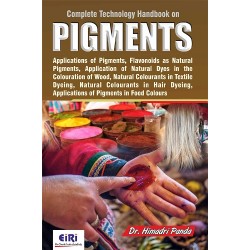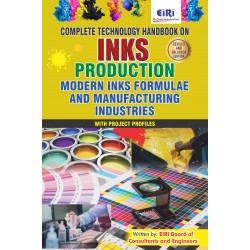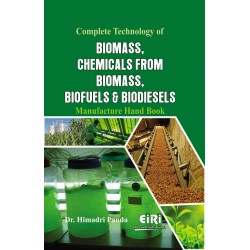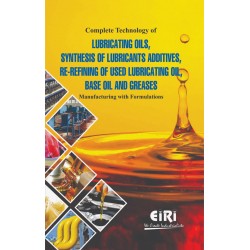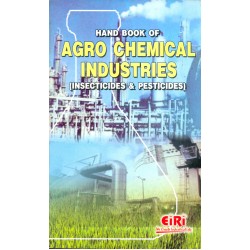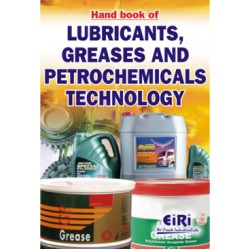Technology of Lubrication & Lubricants, Crude Oil Processing, Catalysts in Petroleum Refining and Petrochemical Processes with Mineral Turpentine Oil
-550x550h.jpeg)
- More than 40 years of experience
- Managed by expert industrial consultants
- ISO 9001-2015 Certified
- Registered under MSME, UAM No: DL01E0012000
- 24/5 Research Support
Get your quesries resolved from an industry expert. Ask your queries before report or book purchase. - Custom Research Service
Speak to the our consultant to design an exclusive study to serve your research needs. - Quality Assurance
All reports are prepared by highly qualified consultants & verified by a panel of experts. - Information Security
Your personal & confidential information is safe & secure.
The Book covers the following chapters: Lubrication and Lubricants, Benzene, Ethylene, Monoethylene Glycol, Diethylene Glycol, Triethylene Glycol, Ethylene Oxide, Toluene, Xylene, Petroleum jelly, Bioethanol Production From Sugar Cane Molasses, Production of Bio-ethanol from Molasses by Schizosaccharomyces Species, Petroleum Crude Oils, Crude Oil Processing, Chemicals Based on Methane, Ethane and Higher Paraffins-Based Chemicals, Chemicals Based On Ethylene, Chemicals Based on Propylene, C4 Oleffins and Diolefins- Based Chemicals, Chemicals Based on Benzene, Toluene, and Xylenes, Synthetic Petroleum-Based Polymers, Catalysts in Petroleum Refining and Petrochemical Processes, Petrochemicals Future, Plant Economics of Mineral Turpentine Oil (MTO), Plant Economics of Lubricating Oil (20w40 Grade SN Type), Plant Economics of Oil Re-refining Unit, Plant Economics of Crude Oil Refining.
- Functions of Lubricants
- Lubrication Principles
- Tests of Lubricants
- Lubricants of Mineral Origin
- Synthetic Lubricants
- Manufacturing Process From Petroleum by
- Catalytic Reforming
- From Refinery Gas by Thermal Cracking
- Molecular Formula
- Molecular Formula
- Monoethylene Glycol From Ethylene and Oxygen
- Uses
- Grades
- Toxicity
- Molecular Formula
- Properties
- Manufacturing Process
- From Ethylene and Oxygen
- Raw material requirement
- Properties
- Manufacturing Process
- From Petroleum by Hydroforming
- Raw material requirement
- Properties of Xylene Isomers
- Manufacturing Process
- Form Petroleum by Catalytic Reforming or
- hydroforming
- Physical properties
- Comparison with glycerol
- Uses
- Medical treatment
- Skin and hair care
- Preventing moisture loss
- Hair grooming
- Skin lubrication
- Product care and protection
- Coating
- Finishing
- Lubrication
- Production processes
- Tattooing
- Explosives
- Mechanical, barrier functions
- Surface cleansing
- Pet care
- Clean-up
- Properties of Petroleum Jelly
- Skin Care
- Face Care
- Hair Care
- Nail Care
- Household Needs
- Ethanol
- Feedstock for bioethanol production
- Sucrose-containing feedstocks
- Starchy materials
- Lignocellulosic biomass
- Ethanol from cane molasses
- Processes of ethanol production
- Introduction
- Materials And Methods
- Collection of Samples
- Isolation of Schizosaccharomyces
- Production of Ethanol from Molasses
- Identification of the Microorganisms
- Originally Present in Molasses
- Inoculation of Molasses by Isolated Yeast
- Distillation and Detection of Ethanol
- Results And Discussion
- Isolation of Schizosaccharomyces
- Species
- Physical Characteristics of the
- Molasses Sample
- Microorganisms Originally Present
- in Molasses
- Production of Ethanol from Raw
- Molasses
- Production of Ethanol from Molasses
- with Different Concentrations of Sucrose
- Detection of Ethanol
- Composition of Crude Oils
- Hydrocarbon Compounds
- Alkanes (Paraffins)
- Cycloparaffins (Naphthenes)
- Aromatic Compounds
- Non-hydrocarbon Compounds
- Sulfur Compounds
- Acidic Sulfur Compounds
- Non-acidic Sulfur Compounds
- Nitrogen Compounds
- Basic Nitrogen Compounds
- Non-Basic Nitrogen Compounds
- Oxygen Compounds
- Acidic Oxygen Compounds
- Non-Acidic Oxygen Compounds
- Metallic Compounds
- Density, Specific Gravity and API Gravity
- Salt Content
- Sulfur Content
- Pour Point
- Ash Content
- Physical Separation Processes
- Atmospheric Distillation
- Vacuum Distillation
- Absorption Process
- Adsorption Process
- Solvent Extraction
- Conversion Processes
- Thermal Conversion Processes
- Coking Processes
- Thermal Cracking Reactions
- Delayed Coking
- Fluid Coking
- Viscosity Breaking (Vis-breaking)
- Catalytic Conversion Processes
- Catalytic Reforming
- Reformer Feeds
- Reforming Catalysts
- Reforming Reactions
- From Acetylene and Acetone
- From Isobutylene and Formaldehyde (IFP Process)
- From Isobutylene and Methylal (Sun Oil Process)
- From Propylene (Goodyear Process)
- Chemicals Based On Direct Reactions of Methane
- Carbon Disulfide (CS)
- Uses Of Carbon Disulfide
- Hydrogen Cyanide (Hcn)
- Chloromethanes
- Production of Chloromethanes
- Uses of Chloromethanes
- SYNTHESIS GAS
- CHEMICALS BASED ON SYNTHESIS GAS
- AMMONIA (NH)
- Uses of Ammonia
- Nitric Acid (HNO)
- Hydrazine (HN-NH).
- Methylalcohol (CHOH)
- Production of Methanol
- Uses of Methanol
- Methyl Chloride (CHCI)
- Acetic Acid (CHCOOH)
- Methyl Tertiary Butyl Ether ((CH)C-O-CH)
- Dimethyl Carbonate (CO(OCH))
- Methylamines
- Ethylene Glycol
- Ethane Chemicals
- Propane Chemicals
- Oxidation of Propane
- Nitration of Propane (Production of Nitroparaffins)
- N-butane Chemicals
- Oxidation of N-butane (Acetic Acid and
- Acetaldehyde)
- Maleic Anhydride:
- Aromatics Production
- Isobutane Chemicals
- Naphtha-based Chemicals
- Chemicals From High Molecular Weight
- N-paraffins
- Oxidation Of Paraffins (Fatty Acids And Fatty
- Alcohols)
- Chlorination Of N-paraffins (Chloroparaffins)
- Introduction
- Oxidation Of Ethylene
- Derivatives of Ethylene Oxide
- Ethylene Glycol (CHOHCHOH)
- Ethoxylates
- Ethanolamines
- ,-Propanediol
- Acetaldehyde (Chcho)
- Important Chemicals From Acetaldehyde
- Acetic Acid
- N-butanol
- Oxidative Carbonylation of Ethylene
- Chlorination of Ethylene
- Vinyl Chloride (Ch=Chcl)
- Linear Alcohols
- Oxidation of Propylene
- Acrolein (CH=CHCHO)
- Uses of Acrolein
- Ammoxidation Of Propylene
- (Acrylonitrile [CH=CHCN])
- Uses of Acrylonitrile
- Adiponitrile (NC(CH)CN)
- Deriatives and Uses of Propylene Oxide
- Propylene Glycol (CHCH(OH)CHOH)
- Allyl Alcohol (CH=CHCHOH)
- Oxyacylation of Propylene
- Chlorination of Propylene
- (Allyl Chloride [Ch=Chchcl])
- Hydration of Propylene
- (Isopropanol [Chchohch])
- Properties And Uses of Isopropanol
- Acetone Production
- Propertles and Uses of Acetone
- Introduction
- Chemicals From N-butenes
- Oxidation of Butenes
- Acetic Acid CHCOH
- Reactions and Chemicals of Benzene
- Reactions and Chemicals of Toluene
- Oxidation of Toluene
- Caprolactam Production
- Phenol from Benzoic Acid
- Terephthalic Acid from Benzoic Acid
- Chlorination of Toluene
- Nitration of Toluene
- Carbonylation of Toluene
- Chemicals From Xylenes
- Terephthalic Acid (Hoocc6h4cooh)
- Introduction
- Thermoplastics And Engineering Resins
- Polyethylene
- Low-Density Polyethylene
- High-Density Polyethylene
- Linear Low-Density Polyethylene
- Properties and Uses of Polyethylenes
- Polypropylene
- Copolymerization
- Properties and Uses of Polypropylene
- Properties and Uses of Polyvinyl Chloride
- Properties and Uses of Styrene Polymers
- Nylon Resins
- Thermoplastic Polyesters
- Polycarbonates
- Properties and Uses of Polycarbonates
- Polyether Sulfones
- Properties and Uses of Aromatic Polyether Sulfones
- Poly(phenylene) Oxide
- Polyacetals
- Thermosetting Plastics
- Polyurethanes
- Properties and Uses of Polyurethanes
- Epoxy Resins
- Properties and Uses of Epoxy Resins
- Unsaturated Polyesters
- Phenol-formaldehyde Resins
- Properties and Uses of Phenolic Resins
- Amino Resins (Aminoplasts)
- Urea-Formaldehyde and Urea-Melamine Resins
- Properties and Uses of Aminoplasts
- Polycyanurates
- Synthetic Rubber
- Butadiene Polymers And Copolymers
- Properties and Uses of Polybutadiene
- Styrene-Butadiene Rubber (SBR)
- Nitrile Rubber (Nbr)
- Polyisoprene
- Properties and Uses of Polyisoprene
- Polychloroprene (Neoprene Rubber)
- Butyl Rubber
- Ethylene-propylene Rubber
- Transpolypentamer
- Thermoplastic Elastomers
- Synthetic Fibers
- Polyester Fibers
- Polyethylene Terephthalate Production
- Properties and Uses of Polyesters
- Polyamides (Nylon Fibers)
- Nylon (Polyhexamethyleneadipate)
- Nylon (Polycaproamide)
- Nylon (Polylaurylamide)
- Nylon (Polybutyramide)
- Nylon (Polyundecanylamide)
- Other Nylon Polymers
- Properties and Uses of Nylons
- Acrylic And Modacrylic Fibers
- Properties and Uses of Polyacrylics
- Carbon Fibers (Graphite Fibers)
- Polypropylene Fibers
- Introduction
- Homogeneous and Heterogeneous Catalysts
- Catalyst Morphology and Activity
- Catalysts for Petroleum Refining
- Cracking Catalysts
- Reforming Catalysts
- Hydrotreating Catalysts
- Catalysts For Petrochemicals Industry
- Catalysts For Synthesis Gas
- Hydrogenation Catalysts
- Hydrocarbon Oxidation Catalysts
- Polymerization Catalysts
- Recent Advances in Industrial Catalysis
- Dual-Function Catalysts
- Super-Active Metal Catalysts
- Supported-Ziegler Catalysts
- Advances in Homogeneous Catalysis
- Role of Polymers in Catalysis
- Integrated Petrochemicals Complex
- Natural Gas As Petrochemical Feedstock
- Impact Of Heavy Feedstocks
- On Petro-chemicals
- Ecology And The Energy Crisis
- Coal As An Alternative To Oil
- Energy Crisis and the Industrial Fuels
- Natural Fuels
- Synthetic Fuels
- Hydrogen: Fuel for tomorrow
- Trends in Petrochemical Industry
- Development in Cracking Technology
- Olefins Vs Paraffins
- Prospect for Propylene
- Size of Plant
- Biomass: Renewable Resource for Petrochemicals
- Waste Disposal
- Plant & Machinery
- Fixed Capital
- Raw Materials
- Total Working Capital/Month
- Total Capital Investment
- Turn Over/Annum
- Plant & Machinery
- Fixed Capital
- Raw Materials
- Total Working Capital/Month
- Total Capital Investment
- Turn Over/Annum
- Plant & Machinery
- Fixed Capital
- Raw Materials
- Total Working Capital/Month
- Total Capital Investment
- Turn Over/Annum
- Plant & Machinery
- Fixed Capital
- Raw Materials
- Total Working Capital/Month
- Total Capital Investment
- Turn Over/Annum
How to Make Project Report?
Detailed Project Report (DPR) includes Present Market Position and Expected Future Demand, Technology, Manufacturing Process, Investment Opportunity, Plant Economics and Project Financials. comprehensive analysis from industry covering detailed reporting and evaluates the position of the industry by providing insights to the SWOT analysis of the industry.
Each report include Plant Capacity, requirement of Land & Building, Plant & Machinery, Flow Sheet Diagram, Raw Materials detail with suppliers list, Total Capital Investment along with detailed calculation on Rate of Return, Break-Even Analysis and Profitability Analysis. The report also provides a birds eye view of the global industry with details on projected market size and then progresses to evaluate the industry in detail.
We can prepare detailed project report on any industry as per your requirement.
We can also modify the project capacity and project cost as per your requirement. If you are planning to start a business, contact us today.
Detailed Project Report (DPR) gives you access to decisive data such as:
- Market growth drivers
- Factors limiting market growth
- Current market trends
- Market structure
- Key highlights
Overview of key market forces propelling and restraining market growth:
- Up-to-date analyses of market trends and technological improvements
- Pin-point analyses of market competition dynamics to offer you a competitive edge major competitors
- An array of graphics, BEP analysis of major industry segments
- Detailed analyses of industry trends
- A well-defined technological growth with an impact-analysis
- A clear understanding of the competitive landscape and key product segments
Need Customized Project Report?
- Ask for FREE project related details with our consultant/industry expert.
- Share your specific research requirements for customized project report.
- Request for due diligence and consumer centric studies.
- Still haven't found what you're looking for? Speak to our Custom Research Team
About Engineers India Research Institute:
Note: We can also prepare project report on any subject based on your requirement and country. If you need, we can modify the project capacity and project cost based on your requirement.
Our Clients

Our Approach
- Our research reports comprehensively cover Indian markets (can be modified as per your country), present investigation, standpoint and gauge for a time of five years*.
- The market conjectures are produced on the premise of optional research and are cross-accepted through associations with the business players
- We use dependable wellsprings of data and databases. What's more, data from such sources is handled by us and incorporated into the report
Why buy EIRI reports?
- Our project reports include detailed analysis that help to get industry Present Market Position and Expected Future Demand.
- Offer real analysis driving variables for the business and most recent business sector patterns in the business
- This report comprehends the present status of the business by clarifying a complete SWOT examination and investigation of the interest supply circumstance
- Report gives investigation and top to bottom money related correlation of real players/competitors
- The report gives gauges of key parameters which foresees the business execution





















